Portable Drowsiness Detection through Use of a Prefrontal Single-Channel Electroencephalogram
Abstract
1. Introduction
2. Model Development
2.1. Materials and Methods
2.1.1. EEG Recordings
2.1.2. Experimental Procedure
2.1.3. Denoising and Artifact Removal
2.1.4. Feature Extractions
2.1.5. Pattern Recognition
2.2. Results
3. Practical Experiment
3.1. Experimental Procedure
3.2. Results
4. Discussion
4.1. Accuracy of Drowsiness Detection
4.2. Selected Features and Parameters
4.3. Limitations
5. Conclusions
Author Contributions
Funding
Acknowledgments
Conflicts of Interest
References
- Lin, C.T.; Wu, R.C.; Liang, S.F.; Chao, W.H.; Chen, Y.J.; Jung, T.P. EEG-based drowsiness estimation for safety driving using independent component analysis. IEEE Trans. Circuits Syst. I Regul. Pap. 2005, 52, 2726–2738. [Google Scholar]
- Shan, X.; Yang, E.H.; Zhou, J.; Chang, V.W.C. Human-building interaction under various indoor temperatures through neural-signal electroencephalogram (EEG) methods. Build. Environ. 2018, 129, 46–53. [Google Scholar] [CrossRef]
- Lee, B.G.; Lee, B.L.; Chung, W.Y. Mobile healthcare for automatic driving sleep-onset detection using wavelet-based EEG and respiration signals. Sensors 2014, 14, 17915–17936. [Google Scholar] [CrossRef] [PubMed]
- Borghini, G.; Astolfi, L.; Vecchiato, G.; Mattia, D.; Babiloni, F. Measuring neurophysiological signals in aircraft pilots and car drivers for the assessment of mental workload, fatigue and drowsiness. Neurosci. Biobehav. Rev. 2014, 44, 58–75. [Google Scholar] [CrossRef] [PubMed]
- Yeo, M.V.; Li, X.; Shen, K.; Wilder-Smith, E.P. Can SVM be used for automatic EEG detection of drowsiness during car driving? Saf. Sci. 2009, 47, 115–124. [Google Scholar] [CrossRef]
- Mardi, Z.; Ashtiani, S.N.M.; Mikaili, M. EEG-based drowsiness detection for safe driving using chaotic features and statistical tests. J. Med. Signals Sens. 2011, 1, 130–137. [Google Scholar] [PubMed]
- Wei, C.S.; Wang, Y.T.; Lin, C.T.; Jung, T.P. Toward drowsiness detection using non-hair-bearing EEG-based brain-computer interfaces. IEEE Trans. Neural Syst. Rehabil. Eng. 2018, 26, 400–406. [Google Scholar] [CrossRef] [PubMed]
- Vuckovic, A.; Radivojevic, V.; Chen, A.C.; Popovic, D. Automatic recognition of alertness and drowsiness from EEG by an artificial neural network. Med. Eng. Phys. 2002, 24, 349–360. [Google Scholar] [CrossRef]
- Coan, J.A.; Allen, J.J. Frontal EEG asymmetry as a moderator and mediator of emotion. Biol. Psychol. 2004, 67, 7–50. [Google Scholar] [CrossRef] [PubMed]
- Petrantonakis, P.C.; Hadjileontiadis, L.J. Emotion recognition from EEG using higher order crossings. IEEE Trans. Inf. Technol. Biomed. 2010, 14, 186–197. [Google Scholar] [CrossRef] [PubMed]
- Zhang, X.; Li, J.; Liu, Y.; Zhang, Z.; Wang, Z.; Luo, D.; Zhou, X.; Zhu, M.; Salman, W.; Hu, G.; et al. Design of a fatigue detection system for high-speed trains based on driver vigilance using a wireless wearable EEG. Sensors 2017, 17, 486. [Google Scholar] [CrossRef] [PubMed]
- Berthomier, C.; Drouot, X.; Herman-Stoïca, M.; Berthomier, P.; Prado, J.; Bokar-Thire, D.; Benoit, O.; Mattout, J.; d’Ortho, M.P. Automatic analysis of single-channel sleep EEG: Validation in healthy individuals. Sleep 2007, 30, 1587–1595. [Google Scholar] [CrossRef] [PubMed]
- Sauvet, F.; Bougard, C.; Coroenne, M.; Lely, L.; Van Beers, P.; Elbaz, M.; Guillard, M.; Leger, D.; Chennaoui, M. In-flight automatic detection of vigilance states using a single EEG channel. IEEE Trans. Biomed. Eng. 2014, 61, 2840–2847. [Google Scholar] [CrossRef] [PubMed]
- Da Silveira, T.L.; Kozakevicius, A.J.; Rodrigues, C.R. Automated drowsiness detection through wavelet packet analysis of a single EEG channel. Expert Syst. Appl. 2016, 55, 559–565. [Google Scholar] [CrossRef]
- Åkerstedt, T.; Gillberg, M. Subjective and objective sleepiness in the active individual. Int. J. Neurosci. 1990, 52, 29–37. [Google Scholar] [CrossRef] [PubMed]
- Gillberg, M.; Kecklund, G.; Åkerstedt, T. Relations between performance and subjective ratings of sleepiness during a night awake. Sleep 1994, 17, 236–241. [Google Scholar] [CrossRef] [PubMed]
- Murata, A.; Fujii, Y.; Naitoh, K. Multinomial logistic regression model for predicting driver’s drowsiness using behavioral measures. Procedia Manuf. 2015, 3, 2426–2433. [Google Scholar] [CrossRef]
- Guyatt, G.H.; Townsend, M.; Berman, L.B.; Keller, J.L. A comparison of Likert and visual analogue scales for measuring change in function. J. Chronic Dis. 1987, 40, 1129–1133. [Google Scholar] [CrossRef]
- Kaida, K.; Takahashi, M.; Åkerstedt, T.; Nakata, A.; Otsuka, Y.; Haratani, T.; Fukasawa, K. Validation of the Karolinska sleepiness scale against performance and EEG variables. Clin. Neurophysiol. 2006, 117, 1574–1581. [Google Scholar] [CrossRef] [PubMed]
- Horne, J.A.; Baulk, S.D. Awareness of sleepiness when driving. Psychophysiology 2004, 41, 161–165. [Google Scholar] [CrossRef] [PubMed]
- Otmani, S.; Pebayle, T.; Roge, J.; Muzet, A. Effect of driving duration and partial sleep deprivation on subsequent alertness and performance of car drivers. Physiol. Behav. 2005, 84, 715–724. [Google Scholar] [CrossRef] [PubMed]
- Van den Berg, J.; Neely, G.; Nilsson, L.; Knutsson, A.; Landström, U. Electroencephalography and subjective ratings of sleep deprivation. Sleep Med. 2005, 6, 231–240. [Google Scholar] [CrossRef] [PubMed]
- Liira, J.; Verbeek, J.H.; Costa, G.; Driscoll, T.R.; Sallinen, M.; Isotalo, L.K.; Ruotsalainen, J.H. Pharmacological interventions for sleepiness and sleep disturbances caused by shift work. Cochrane Database Syst. Rev. 2014. [Google Scholar] [CrossRef] [PubMed]
- Ahonen, L.; Cowley, B.; Torniainen, J.; Ukkonen, A.; Vihavainen, A.; Puolamäki, K. Cognitive collaboration found in cardiac physiology: Study in classroom environment. PLoS ONE 2016, 11, e0159178. [Google Scholar] [CrossRef] [PubMed]
- Awais, M.; Badruddin, N.; Drieberg, M. A hybrid approach to detect driver drowsiness utilizing physiological signals to improve system performance and wearability. Sensors 2017, 17, 1991. [Google Scholar] [CrossRef] [PubMed]
- Makeig, S.; Jung, T.P.; Sejnowski, T.J. Awareness during drowsiness: Dynamics and electrophysiological correlates. Can. J. Exp. Psychol. 2000, 54, 266–273. [Google Scholar] [CrossRef] [PubMed]
- Subasi, A. Automatic recognition of alertness level from EEG by using neural network and wavelet coefficients. Expert Syst. Appl. 2005, 28, 701–711. [Google Scholar] [CrossRef]
- Krusienski, D.J.; Sellers, E.W.; Cabestaing, F.; Bayoudh, S.; McFarland, D.J.; Vaughan, T.M.; Wolpaw, J.R. A comparison of classification techniques for the P300 Speller. J. Neural Eng. 2006, 3, 299–305. [Google Scholar] [CrossRef] [PubMed]
- Mowla, M.R.; Huggins, J.E.; Thompson, D.E. Enhancing P300-BCI performance using latency estimation. Brain-Comput. Interfaces 2017, 4, 137–145. [Google Scholar] [CrossRef] [PubMed]
- Hsu, C.W.; Lin, C.J. A comparison of methods for multiclass support vector machines. IEEE Trans. Neural Netw. 2002, 13, 415–425. [Google Scholar] [PubMed]
- Wang, Q.; Sourina, O. Real-time mental arithmetic task recognition from EEG signals. IEEE Trans. Neural Syst. Rehabil. Eng. 2013, 21, 225–232. [Google Scholar] [CrossRef] [PubMed]
- Min, J.; Wang, P.; Hu, J. Driver fatigue detection through multiple entropy fusion analysis in an EEG-based system. PLoS ONE 2017, 12, e0188756. [Google Scholar] [CrossRef] [PubMed]
- Chai, R.; Ling, S.H.; San, P.P.; Naik, G.R.; Nguyen, T.N.; Tran, Y.; Craig, A.; Nguyen, H.T. Improving eeg-based driver fatigue classification using sparse-deep belief networks. Front. Neurosci. 2017, 11, 103. [Google Scholar] [CrossRef] [PubMed]
- De Wel, O.; Lavanga, M.; Dorado, A.C.; Jansen, K.; Dereymaeker, A.; Naulaers, G.; Van Huffel, S. Complexity analysis of neonatal EEG using multiscale entropy: applications in brain maturation and sleep stage classification. Entropy 2017, 19, 516. [Google Scholar] [CrossRef]
- Vidaurre, C.; Sannelli, C.; Müller, K.R.; Blankertz, B. Co-adaptive calibration to improve BCI efficiency. J. Neural Eng. 2011, 8, 025009. [Google Scholar] [CrossRef] [PubMed]
- Käthner, I.; Ruf, C.A.; Pasqualotto, E.; Braun, C.; Birbaumer, N.; Halder, S. A portable auditory P300 brain–computer interface with directional cues. Clin. Neurophysiol. 2013, 124, 327–338. [Google Scholar] [CrossRef] [PubMed]
- Cajochen, C.; Kräuchi, K.; von Arx, M.A.; Möri, D.; Graw, P.; Wirz-Justice, A. Daytime melatonin administration enhances sleepiness and theta/alpha activity in the waking EEG. Neurosci. Lett. 1996, 207, 209–213. [Google Scholar] [CrossRef]
- Bastiaansen, M.; Straatman, S.; Driessen, E.; Mitas, O.; Stekelenburg, J.; Wang, L. My destination in your brain: A novel neuromarketing approach for evaluating the effectiveness of destination marketing. J. Destin. Mark. Manag. 2016. [Google Scholar] [CrossRef]
- Homan, R.W.; Herman, J.; Purdy, P. Cerebral location of international 10–20 system electrode placement. Electroencephalogr. Clin. Neurophysiol. 1987, 66, 376–382. [Google Scholar] [CrossRef]
- Strijkstra, A.M.; Beersma, D.G.; Drayer, B.; Halbesma, N.; Daan, S. Subjective sleepiness correlates negatively with global alpha (8–12 Hz) and positively with central frontal theta (4–8 Hz) frequencies in the human resting awake electroencephalogram. Neurosci. Lett. 2003, 340, 17–20. [Google Scholar] [CrossRef]
- Bos, D.O. EEG-based emotion recognition. Influ. Vis. Audit. Stimul. 2006, 56, 1–17. [Google Scholar]
- Minguillon, J.; Perez, E.; Lopez-Gordo, M.; Pelayo, F.; Sanchez-Carrion, M. Portable System for Real-Time Detection of Stress Level. Sensors 2018, 18, 2504. [Google Scholar] [CrossRef] [PubMed]
- Jadhav, P.; Shanamugan, D.; Chourasia, A.; Ghole, A.; Acharyya, A.; Naik, G. Automated detection and correction of eye blink and muscular artefacts in EEG signal for analysis of Autism Spectrum Disorder. In Proceedings of the 2014 36th Annual International Conference of the IEEE Engineering in Medicine and Biology Society (EMBC), Chicago, IL, USA, 26–30 August 2014; pp. 1881–1884. [Google Scholar]
- Bhardwaj, S.; Jadhav, P.; Adapa, B.; Acharyya, A.; Naik, G.R. Online and automated reliable system design to remove blink and muscle artefact in EEG. In Proceedings of the 2015 37th Annual International Conference of the IEEE Engineering in Medicine and Biology Society (EMBC), Milan, Italy, 25–29 August 2015; pp. 6784–6787. [Google Scholar]
- Joy, J.; Peter, S.; John, N. Denoising using soft thresholding. Int. J. Adv. Res. Electr. Electron. Instrum. Eng. 2013, 2, 1027–1032. [Google Scholar]
- Blackman, R.B.; Tukey, J.W. The measurement of power spectra from the point of view of communications engineering—Part I. Bell Syst. Tech. J. 1958, 37, 185–282. [Google Scholar] [CrossRef]
- Wang, X.W.; Nie, D.; Lu, B.L. Emotional state classification from EEG data using machine learning approach. Neurocomputing 2014, 129, 94–106. [Google Scholar] [CrossRef]
- Uhlhaas, P.J.; Pipa, G.; Neuenschwander, S.; Wibral, M.; Singer, W. A new look at gamma? High-(>60 Hz) γ-band activity in cortical networks: function, mechanisms and impairment. Prog. Biophys. Mol. Biol. 2011, 105, 14–28. [Google Scholar] [CrossRef] [PubMed]
- Brunner, C.; Billinger, M.; Vidaurre, C.; Neuper, C. A comparison of univariate, vector, bilinear autoregressive, and band power features for brain–computer interfaces. Med. Biol. Eng. Comput. 2011, 49, 1337–1346. [Google Scholar] [CrossRef] [PubMed]
- Koley, B.; Dey, D. An ensemble system for automatic sleep stage classification using single channel EEG signal. Comput. Biol. Med. 2012, 42, 1186–1195. [Google Scholar] [CrossRef] [PubMed]
- Ma, Y.; Shi, W.; Peng, C.K.; Yang, A.C. Nonlinear dynamical analysis of sleep electroencephalography using fractal and entropy approaches. Sleep Med. Rev. 2018, 37, 85–93. [Google Scholar] [CrossRef] [PubMed]
- Bandt, C. A new kind of permutation entropy used to classify sleep stages from invisible EEG microstructure. Entropy 2017, 19, 197. [Google Scholar] [CrossRef]
- Liang, S.F.; Kuo, C.E.; Hu, Y.H.; Pan, Y.H.; Wang, Y.H. Automatic Stage Scoring of Single-Channel Sleep EEG by Using Multiscale Entropy and Autoregressive Models. IEEE Trans. Instrum. Meas. 2012, 61, 1649–1657. [Google Scholar] [CrossRef]
- Permana, K.E.; Okamoto, T.; Iramina, K. Single Channel Electroencephalogram Measurement with Multi-scale Entropy Analysis for Evaluating Day Time Sleep. In Proceedings of the International Conference on the Development of Biomedical Engineering in Vietnam; Springer: Singapore, 2017; pp. 431–435. [Google Scholar]
- Chialvo, D.R. Physiology: Unhealthy surprises. Nature 2002, 419, 263. [Google Scholar] [CrossRef] [PubMed]
- Burioka, N.; Miyata, M.; Cornélissen, G.; Halberg, F.; Takeshima, T.; Kaplan, D.T.; Suyama, H.; Endo, M.; Maegaki, Y.; Nomura, T.; et al. Approximate entropy in the electroencephalogram during wake and sleep. Clin. EEG Neurosci. 2005, 36, 21–24. [Google Scholar] [CrossRef] [PubMed]
- Lotte, F.; Congedo, M.; Lécuyer, A.; Lamarche, F.; Arnaldi, B. A review of classification algorithms for EEG-based brain–computer interfaces. J. Neural Eng. 2007, 4, R1. [Google Scholar] [CrossRef] [PubMed]
- Subasi, A.; Gursoy, M.I. EEG signal classification using PCA, ICA, LDA and support vector machines. Expert Syst. Appl. 2010, 37, 8659–8666. [Google Scholar] [CrossRef]
- Liang, N.Y.; Saratchandran, P.; Huang, G.B.; Sundararajan, N. Classification of mental tasks from EEG signals using extreme learning machine. Int. J. Neural Syst. 2006, 16, 29–38. [Google Scholar] [CrossRef] [PubMed]
- Herrera, L.J.; Fernandes, C.M.; Mora, A.M.; Migotina, D.; Largo, R.; Guillén, A.; Rosa, A.C. Combination of heterogeneous EEG feature extraction methods and stacked sequential learning for sleep stage classification. Int. J. Neural Syst. 2013, 23, 1350012. [Google Scholar] [CrossRef] [PubMed]
- Grant, D.A.; Berg, E. A behavioral analysis of degree of reinforcement and ease of shifting to new responses in a Weigl-type card-sorting problem. J. Exp. Psychol. 1948, 38, 404. [Google Scholar] [CrossRef] [PubMed]
- Heaton, R.K.; Chelune, G.J.; Talley, J.L.; Kay, G.G.; Curtiss, G. Wisconsin Card Sorting Test (WCST): Manual: Revised and Expanded; Psychological Assessment Resources (PAR): Lutz, FL, USA, 1993. [Google Scholar]
- Lal, S.K.; Craig, A. Driver fatigue: Electroencephalography and psychological assessment. Psychophysiology 2002, 39, 313–321. [Google Scholar] [CrossRef] [PubMed]
- Fürst, C.; Åhsberg, E. Dimensions of fatigue during radiotherapy. Support. Care Cancer 2001, 9, 355–360. [Google Scholar] [CrossRef] [PubMed]
- Kurt, M.B.; Sezgin, N.; Akin, M.; Kirbas, G.; Bayram, M. The ANN-based computing of drowsy level. Expert Syst. Appl. 2009, 36, 2534–2542. [Google Scholar] [CrossRef]
- Lin, F.C.; Ko, L.W.; Chuang, C.H.; Su, T.P.; Lin, C.T. Generalized EEG-based drowsiness prediction system by using a self-organizing neural fuzzy system. IEEE Trans. Circuits Syst. I Regul. Pap. 2012, 59, 2044–2055. [Google Scholar] [CrossRef]
- Balasubramanian, V.; Jagannath, M.; Adalarasu, K. EEG-based evaluation of viewer’s response towards TV commercials. Int. J. Ind. Syst. Eng. 2013, 13, 480–495. [Google Scholar] [CrossRef]
- Poulsen, A.T.; Kamronn, S.; Dmochowski, J.; Parra, L.C.; Hansen, L.K. EEG in the classroom: Synchronised neural recordings during video presentation. Sci. Rep. 2017, 7, 43916. [Google Scholar] [CrossRef] [PubMed]
- Chen, L.l.; Zhao, Y.; Zhang, J.; Zou, J.Z. Automatic detection of alertness/drowsiness from physiological signals using wavelet-based nonlinear features and machine learning. Expert Syst. Appl. 2015, 42, 7344–7355. [Google Scholar] [CrossRef]
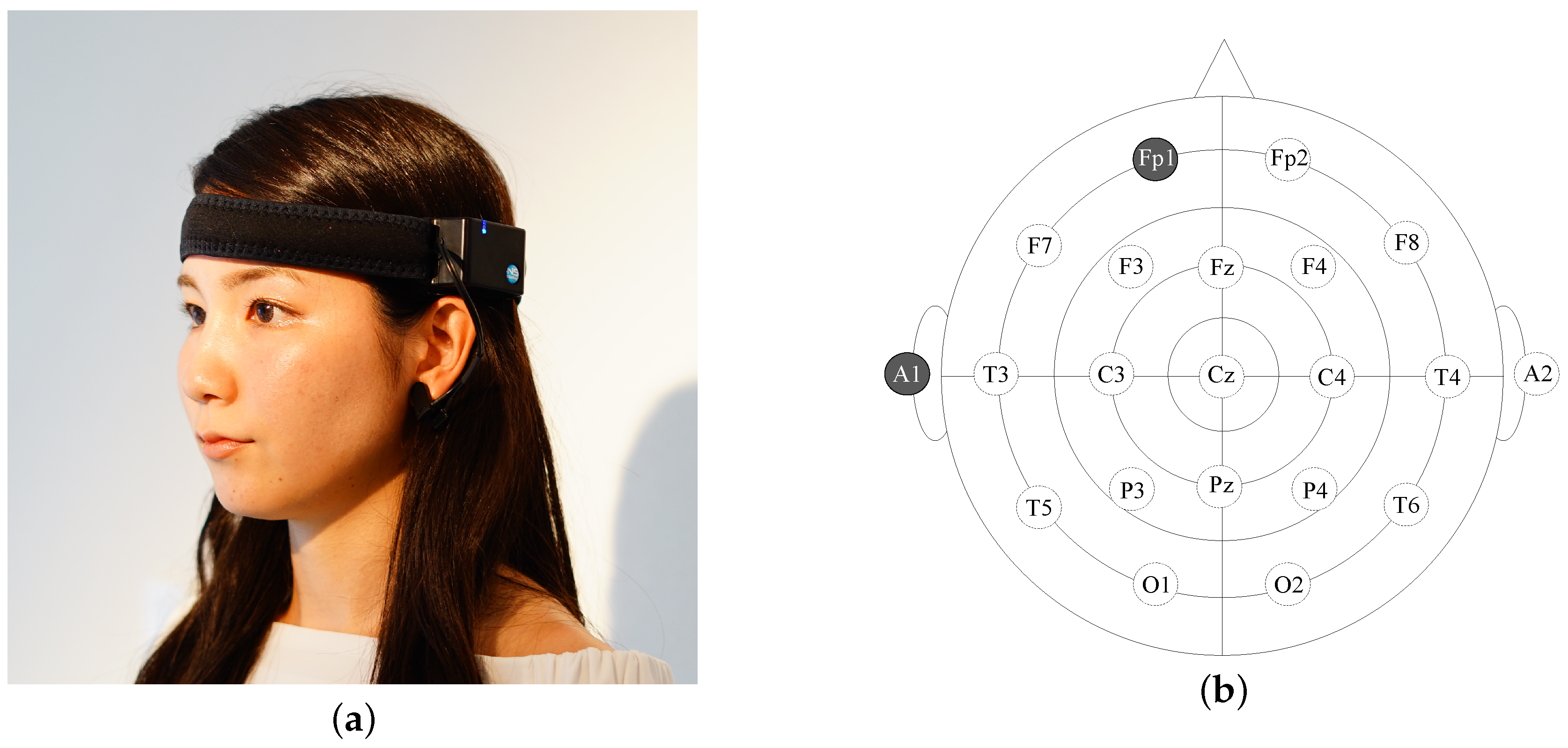
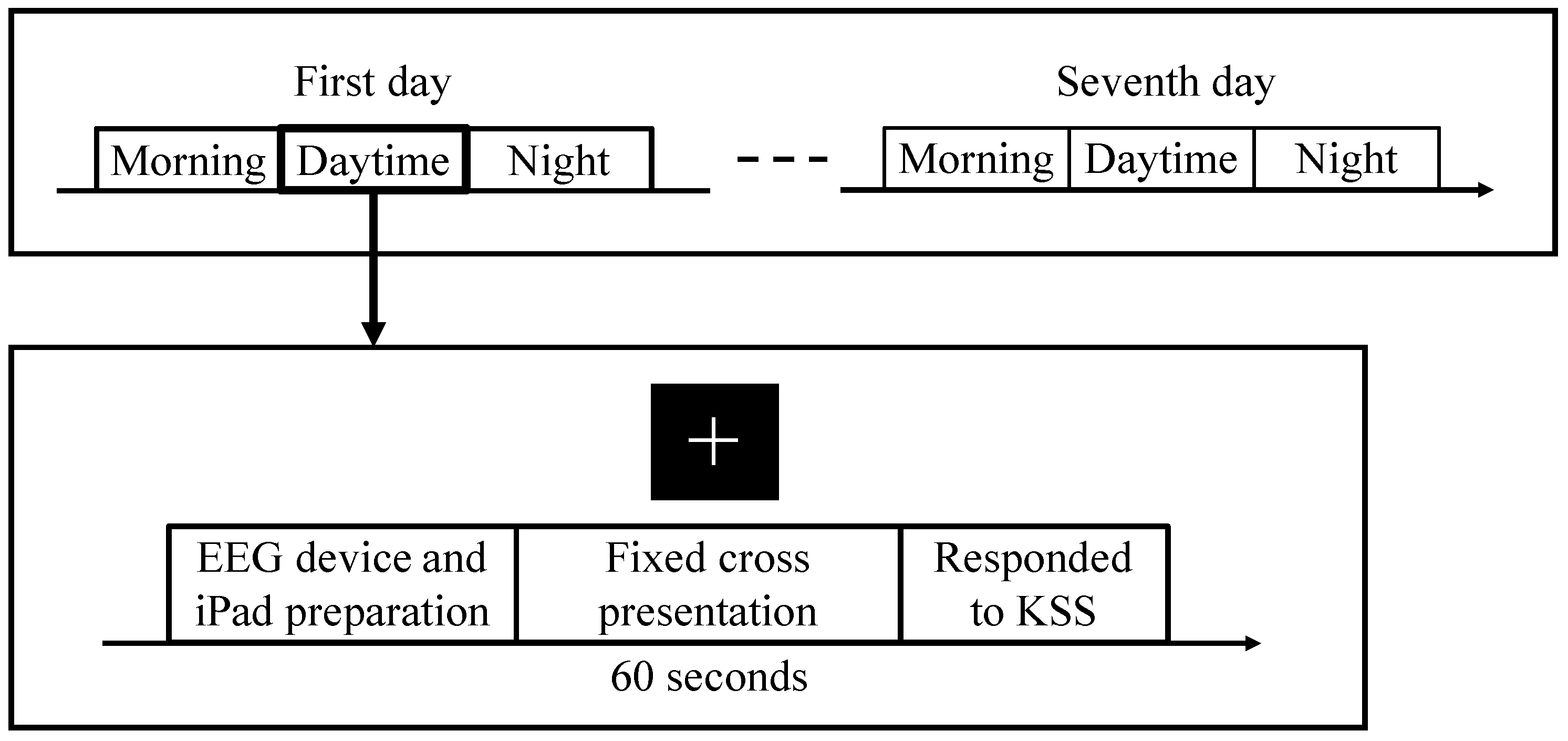
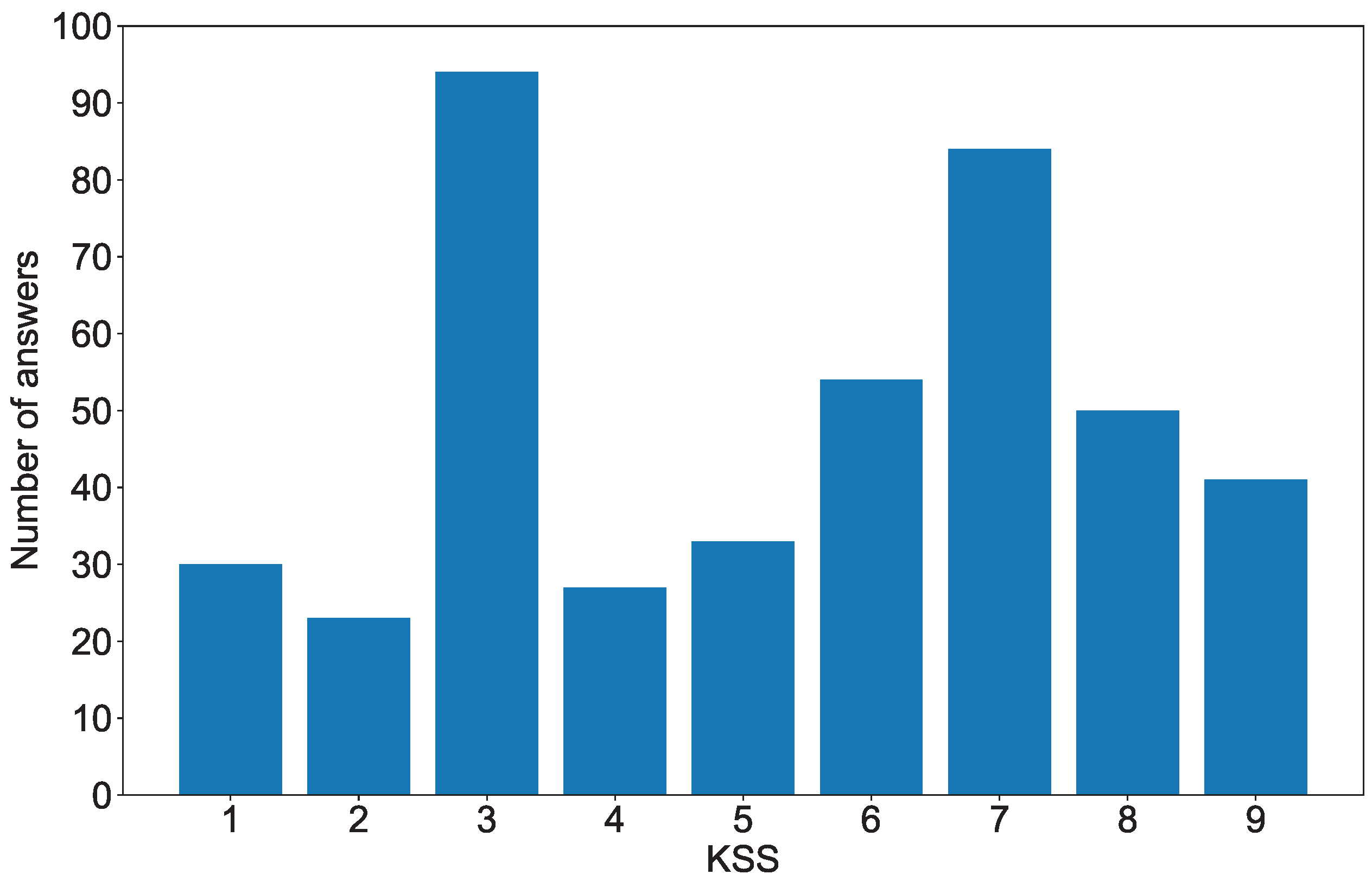
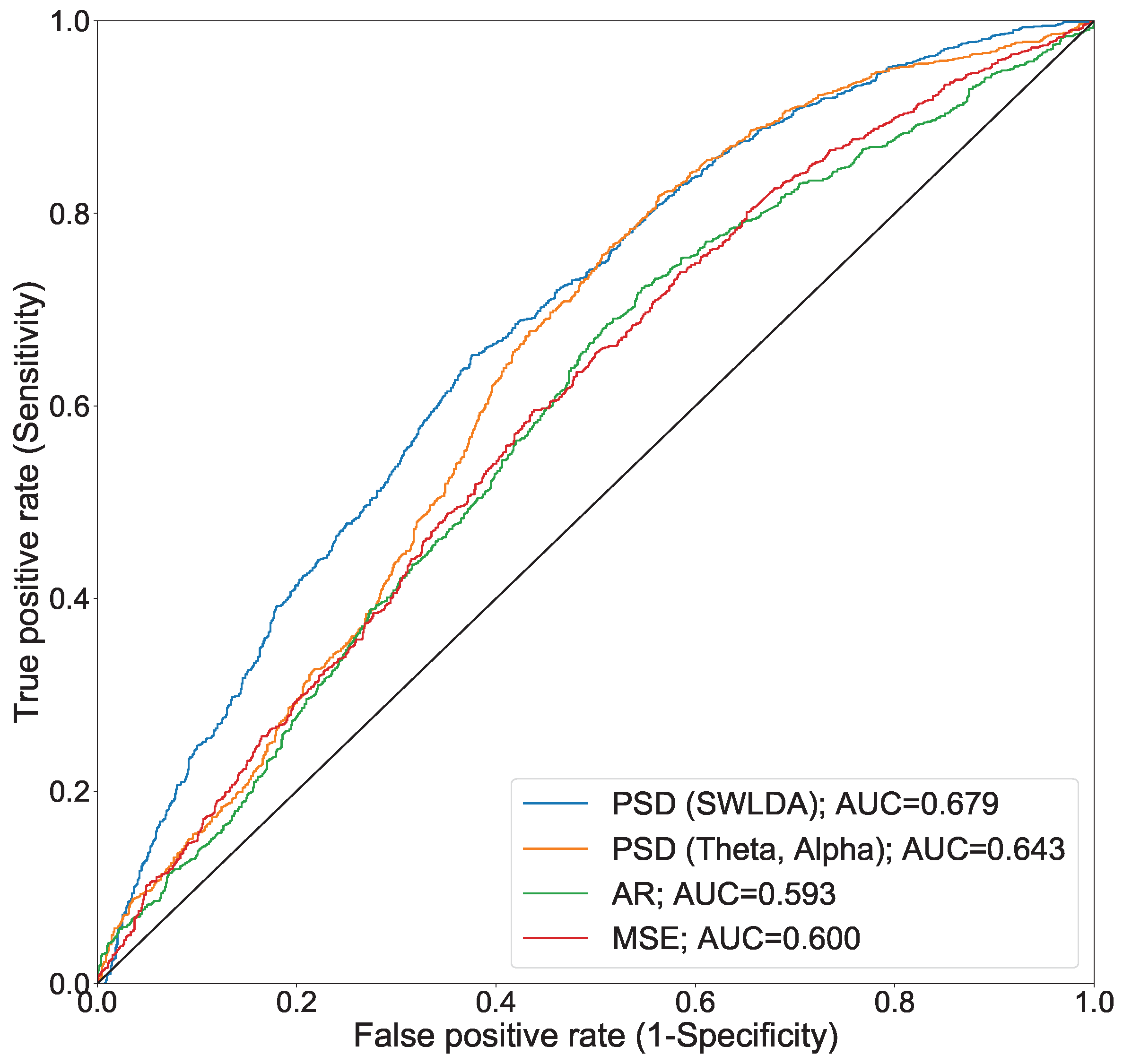


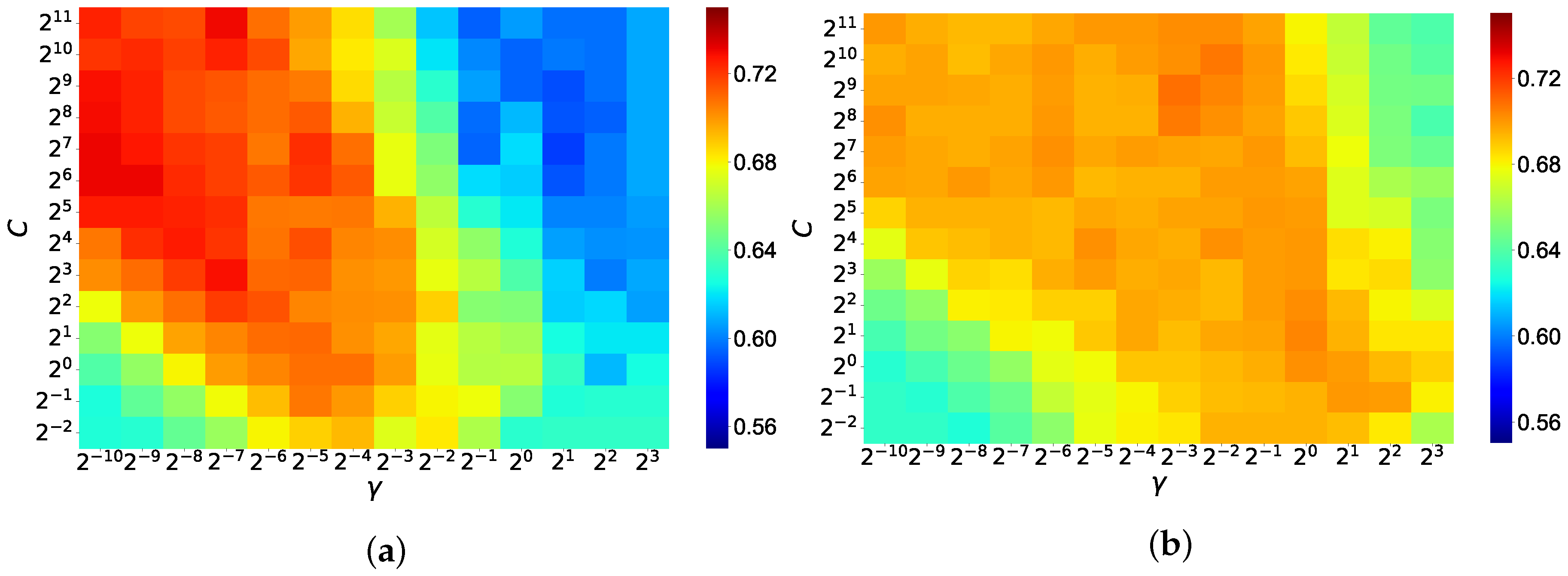
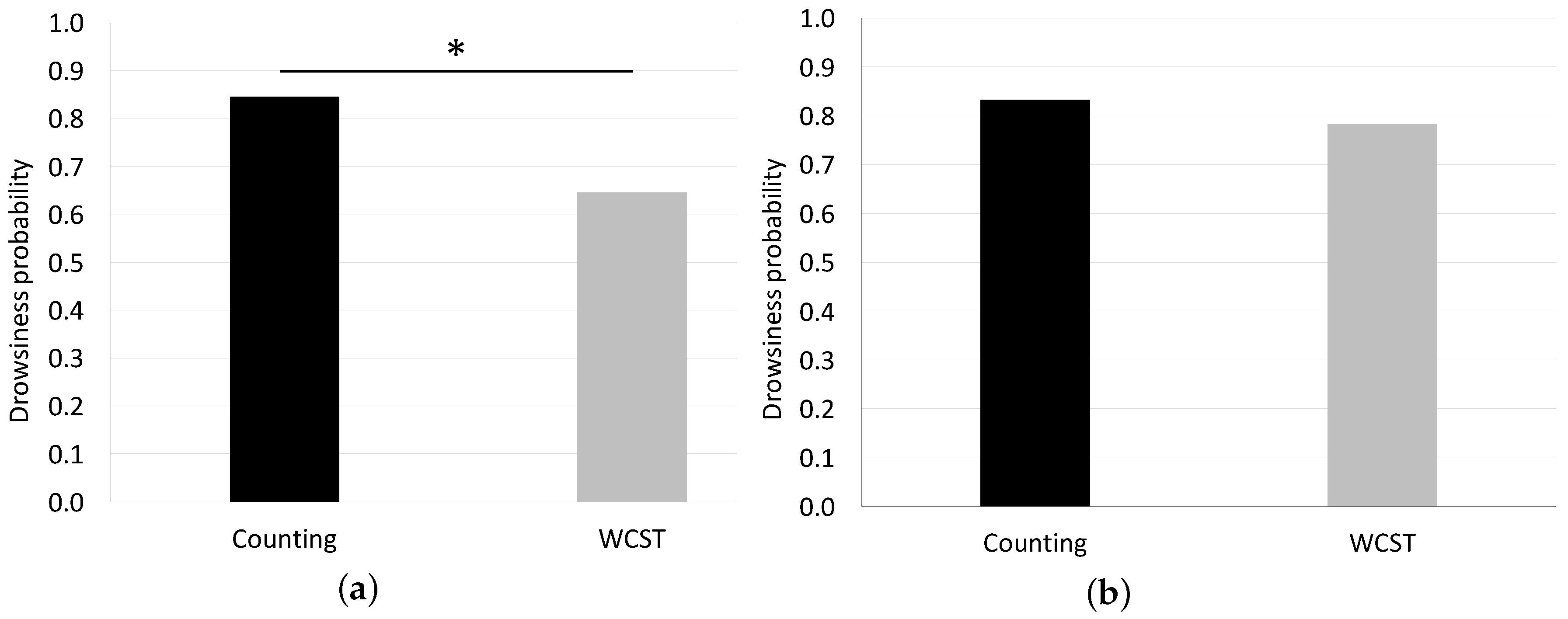
| Criteria | Thresholds | ||
|---|---|---|---|
| 5 | 4 & 6 | 3 & 7 | |
| KSS Sample (Drowsy) | 1354 | 1038 | 538 |
| KSS Sample (Alert) | 1037 | 875 | 314 |
| Criteria | PSD (SWLDA) | PSD (Theta, Alpha) | AR | MSE |
|---|---|---|---|---|
| TP | 1136 | 1172 | 1077 | 1120 |
| FP | 635 | 657 | 690 | 725 |
| FN | 218 | 182 | 277 | 234 |
| TN | 402 | 380 | 347 | 312 |
| Precision (%) | 64.1 | 64.1 | 61.0 | 60.7 |
| Sensitivity (%) | 83.9 | 86.6 | 79.5 | 82.7 |
| Specificity (%) | 38.8 | 36.6 | 33.5 | 30.1 |
| Acc (%) | 64.3 | 64.9 | 59.6 | 59.9 |
| F-measure (%) | 72.7 | 73.6 | 69.0 | 70.0 |
| Criteria | PSD (SWLDA) | PSD (Theta, Alpha) | AR | MSE |
|---|---|---|---|---|
| TP | 771 | 886 | 780 | 689 |
| FP | 361 | 510 | 579 | 507 |
| FN | 267 | 152 | 258 | 349 |
| TN | 514 | 365 | 296 | 368 |
| Precision (%) | 68.1 | 63.5 | 57.4 | 57.6 |
| Sensitivity (%) | 74.3 | 85.4 | 75.1 | 66.4 |
| Specificity (%) | 58.7 | 41.7 | 33.8 | 42.1 |
| Acc (%) | 67.2 | 65.4 | 56.2 | 55.3 |
| F-measure (%) | 71.1 | 72.8 | 65.1 | 61.7 |
| Criteria | PSD (SWLDA) | PSD (Theta, Alpha) | AR | MSE |
|---|---|---|---|---|
| TP | 477 | 492 | 503 | 461 |
| FP | 172 | 209 | 245 | 210 |
| FN | 61 | 46 | 35 | 77 |
| TN | 142 | 105 | 69 | 104 |
| Precision (%) | 73.5 | 70.2 | 67.2 | 68.7 |
| Sensitivity (%) | 88.7 | 91.4 | 93.5 | 85.7 |
| Specificity (%) | 45.2 | 33.4 | 22.0 | 33.1 |
| Acc (%) | 72.7 | 70.1 | 67.1 | 66.3 |
| F-measure (%) | 80.4 | 79.4 | 78.2 | 76.3 |
© 2018 by the authors. Licensee MDPI, Basel, Switzerland. This article is an open access article distributed under the terms and conditions of the Creative Commons Attribution (CC BY) license (http://creativecommons.org/licenses/by/4.0/).
Share and Cite
Ogino, M.; Mitsukura, Y. Portable Drowsiness Detection through Use of a Prefrontal Single-Channel Electroencephalogram. Sensors 2018, 18, 4477. https://doi.org/10.3390/s18124477
Ogino M, Mitsukura Y. Portable Drowsiness Detection through Use of a Prefrontal Single-Channel Electroencephalogram. Sensors. 2018; 18(12):4477. https://doi.org/10.3390/s18124477
Chicago/Turabian StyleOgino, Mikito, and Yasue Mitsukura. 2018. "Portable Drowsiness Detection through Use of a Prefrontal Single-Channel Electroencephalogram" Sensors 18, no. 12: 4477. https://doi.org/10.3390/s18124477
APA StyleOgino, M., & Mitsukura, Y. (2018). Portable Drowsiness Detection through Use of a Prefrontal Single-Channel Electroencephalogram. Sensors, 18(12), 4477. https://doi.org/10.3390/s18124477





